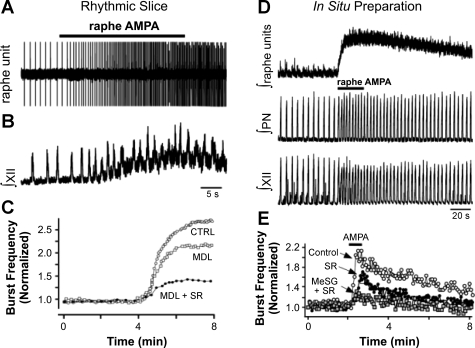Fig. 1.
Raphé-specific stimulation increases hypoglossal (XII) and phrenic motor outputs in vitro and in situ. Individual raphé unit activity (A) and integrated XII motor activity (B) both increase during midline raphé application of α-amino-3-hydroxyl-5-methyl-4-isoxazole-propionate (AMPA) in rhythmic slices. C: the increase in XII motor output can be reduced with bath application of the 5-HT2A receptor antagonist MDL-11,939 (MDL), and further reduced with coapplication of the NK-1 receptor antagonist SR 140333 (SR). CTRL, control. D: similarly, focal application of AMPA into the raphé of perfused brain (in situ) preparations increases raphé unit activity, and phrenic (PN) and XII motor outputs. E: the stimulatory effect of raphé AMPA is blunted or nearly eliminated in situ with SR or methysergide (MeSG) + SR, respectively. [Adapted from Ptak et al. (49) with permission from the Society for Neuroscience.]

